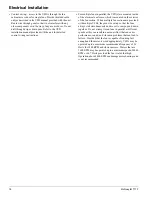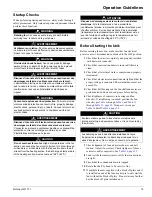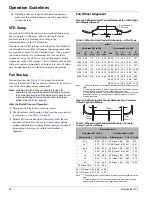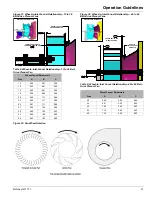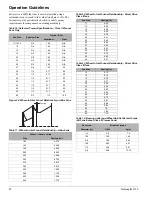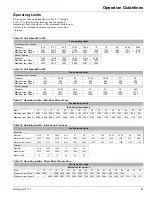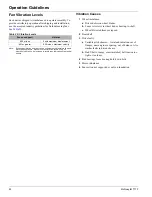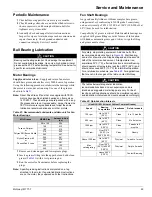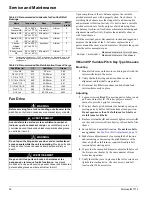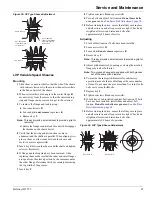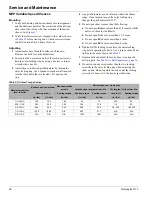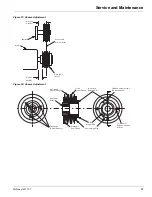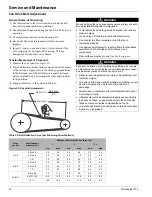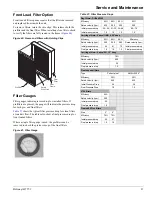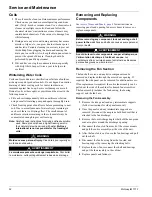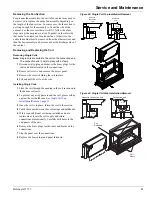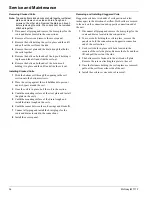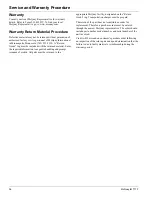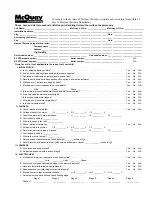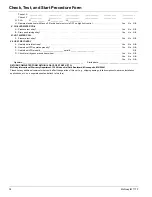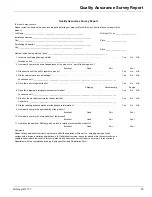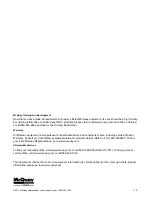
32
McQuay IM 777-7
Service and Maintenance
Coils
1
The coil must be clean to obtain maximum performance.
Check once a year under normal operating conditions
and, if dirty, brush or vacuum clean. Use a chemical coil
cleaner on multiple row coils. Read and follow the
chemical cleaner’s instructions as some cleaners may
contain harsh chemicals. Take care not to damage fins
while cleaning.
2
Drain pans in any air conditioning unit may have some
moisture. Algae, etc., can grow due to airborne spores
and bacteria. Periodic cleaning is necessary to prevent
this buildup from plugging the drain and causing the
drain pan to overflow. Also, keep the drain pans clean to
prevent the spread of disease. Cleaning should be
performed by qualified personnel.
3
Dirt and lint can clog the condensate drain, especially
with dirty filters. Inspect twice a year to help avoid
overflow.
Winterizing Water Coils
Coils can freeze due to air stratification or failure of outdoor
air dampers and/or preheat controls. Do not depend on routine
draining of water cooling coils for winter shutdown as
insurance against freeze-up. Severe coil damage can result.
Drain all coils as thoroughly as possible and then treat in the
following manner.
•
Fill each coil independently with an antifreeze solution
using a small circulating pump and again thoroughly drain.
•
Check freezing point of antifreeze before proceeding to next
coil. Due to a small amount of water always remaining in
each coil, there is a diluting effect. The small amount of
antifreeze solution remaining in the coil must always be
concentrated enough to prevent freeze-up.
Note:
Carefully read instructions for mixing antifreeze solution
used. Some products have a higher freezing point in
their natural state when mixed with water.
McQuay
International is not responsible for the freezing of
coils.
Removing and Replacing
Components
See
Access Doors and Panels‚ page 8
for instructions on
removing panels and opening fan access doors to remove or
replace components.
Removing the Fan Section
The fan shaft, motor, and any drive components can be
removed and replaced through the access door opening. If
required, the side panel can be removed for additional access.
If fan replacement is required, the entire fan assembly can be
pulled out the side of the cabinet for housed fan assemblies.
The fan assembly includes the fan housing, the bearing
support, and the fan base.
Removing the Fan Assembly
1
Remove the side panels and any intermediate supports
(follow instructions for side panel removal).
2
Once the panels and any intermediate supports are
removed, disconnect the neoprene bulk head seal that is
attached to the fan discharge.
3
Remove the four discharge angles that hold the neoprene
canvas in place around the discharge opening.
4
Disconnect the fan sled from each of the corner mounts
and pull the entire assembly out the side of the unit.
5
After the fan sled is out, loosen the fan bearings and pull
out the shaft.
6
Disconnect the fan housing from the fan sled, and
bearing support by removing the attaching bolts.
7
Replace the new fan, reconnect the shaft and bearings
and put the fan assembly in the cabinet.
8
Replace panels and fasteners.
WARNING
Mold can cause personal injury.
Clean drain pan regularly so
mold does not develop.
AVERTISSEMENT
La moisissure présente un danger respiratoire.
Pour éviter
la moisissure, nettoyer régulièrement le bassin de drainage.
WARNING
Before removing any component, lock out and tag out all
power to the unit.
Fans and belts can cause severe personal
injury or death.
AVERTISSEMENT
Avant d’enlever toute composante, couper et indiquer que
l’alimentation électrique à l’unité est coupée.
Les
ventilateurs et les courroies peuvent entraîner des blessures
personelles graves ou même la mort.

